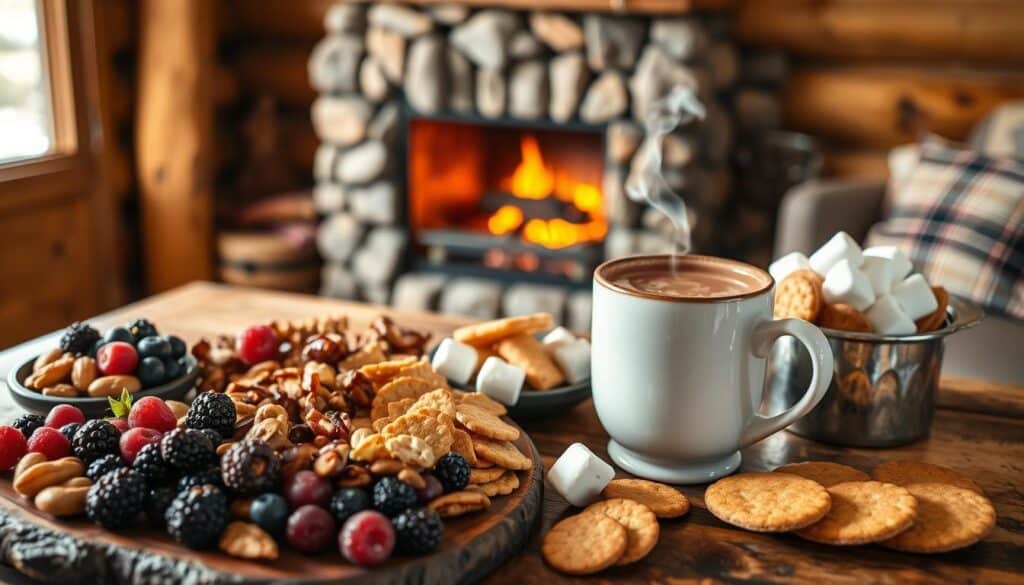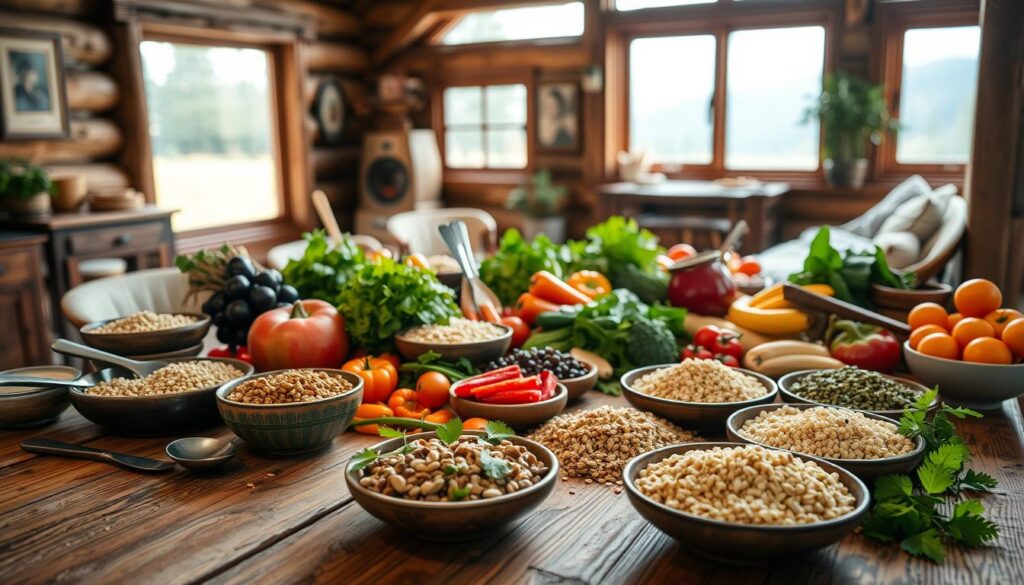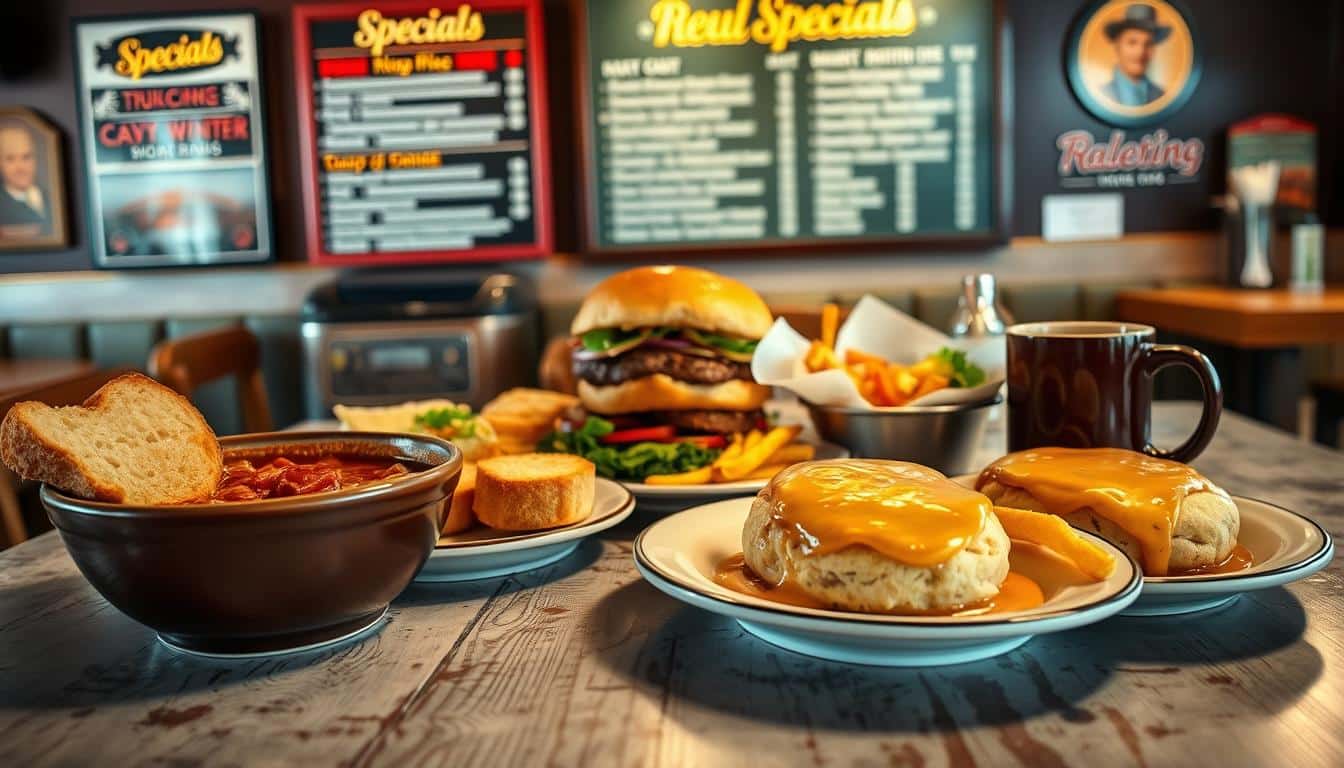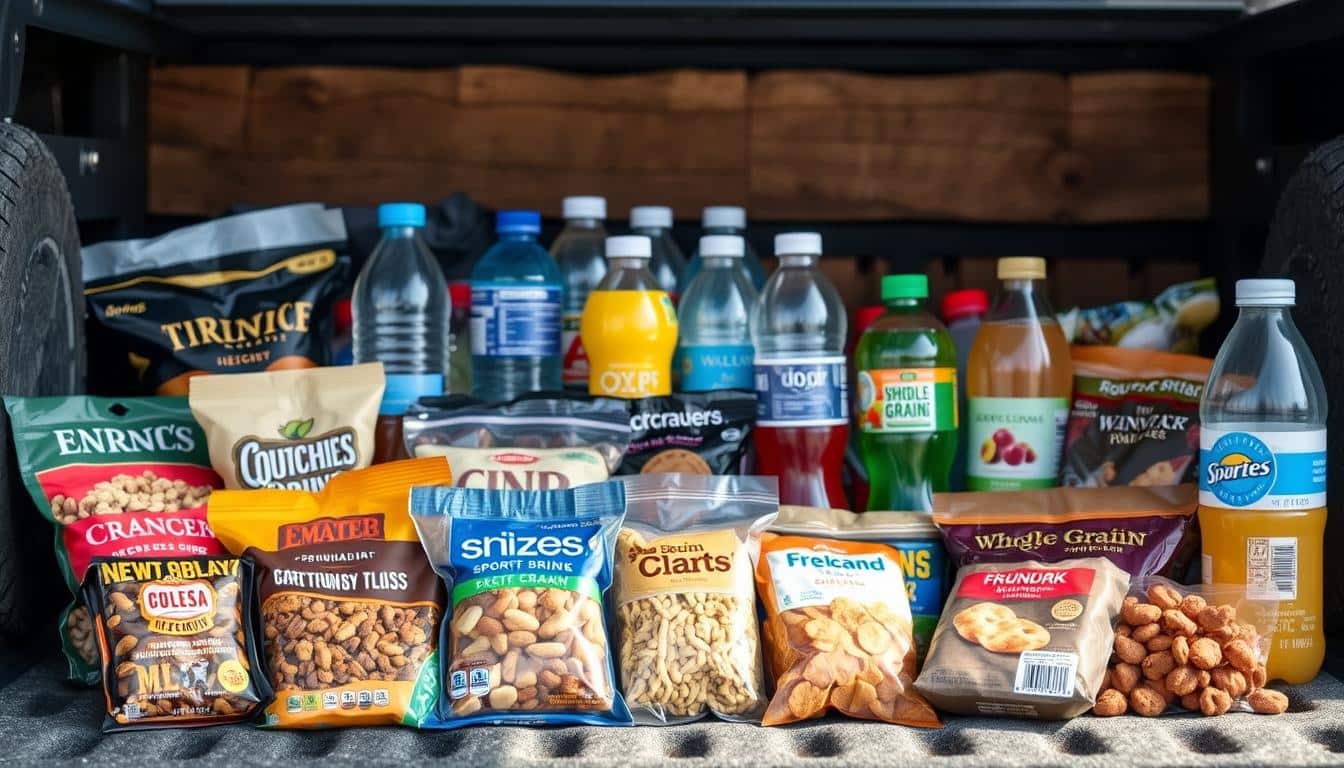The fun of a cabin weekend is largely about the food. Meals like foil-packet dinners bring back good memories, feeling simple yet special. Remember to pack essentials: a Lodge cast iron, foil, and basics like canned beans.
Planning ahead makes meal prep fun, not rushed. Preparing things like sheet pancakes before you leave saves time. This lets you enjoy activities like hiking or relaxing by the fire.
When cooking for many, choose meals everyone loves that are easy to make in big batches. Think of making breakfast burritos or shrimp-boil foil packs. This way, you can have quick breakfasts and filling dinners ready for your outdoor adventures.
Creating a simple snack station or a weekend’s worth of meals can make your trip stress-free and more fun. This guide offers tips on meals you can prepare ahead, easy substitutions, and cleanup tips. These suggestions will help make your trip feel like a getaway focused on delicious food.
Pre-trip Meal Planning and Make-Ahead Strategies
Mornings can be hectic, and late-nights tired. But, a good plan changes that. Combine proteins with carbs for meals. And, choose dishes that travel well. This way, you waste less and have more for your adventures.
Why make-ahead meals save time and reduce stress
Preparing meals before your trip means less cooking at the cabin. Instant Pot carnitas or similar dishes save time. Just reheat them in a skillet. And, don’t forget sauces and toppings for easy meal finishes.
Planning your meals cuts down on emergency store runs. Label everything by day and portion. This keeps mornings easy and lets guests eat when they want.
Best recipes to prep at home: sheet pancakes, brownies, granola clusters, and pre-cooked potatoes
Sheet pancakes are a hit. Try chocolate, berry, or banana. They’re easy to reheat. Brownies are great for breakfast or dessert.
For hiking, pack granola clusters or energy balls. Instant Pot eggs and precooked potatoes work great for meals. And, dishes like pulled pork or lasagna can be reheated outdoors.
Packaging and labeling tips: silicone bags, mason jars, and vacuum sealing for freshness
Pack casseroles flattened in reusable silicone storage bags. It saves space. Use silicone bags for quick breakfasts or lunches, too.
Mason jars are great for oats or salads. Use vacuum seal for proteins and cheese. It keeps things fresh and prevents leaks. Label each item by contents and date. It makes things simpler.
Cooler organization hacks to keep food safe and accessible
Start with a plan for packing the cooler. Raw meats go at the bottom. Drinks should have their own cooler. It keeps the food cooler closed more.
- Pre-chill coolers and use frozen water bottles as both ice and drinking water.
- Layer items by meal order so breakfast is on top for easy access.
- Pack thawing items toward the front to use early in the trip.
These tips help make your camping food last. And, they keep cooking simple. With good packing, you spend more time having fun outdoors.
Cabin food hacks
Small kitchens need clever tricks. Use easy tools and smart swaps to feed many with ease. Bring cast-iron skillets, a Dutch oven, heavy-duty foil, mason jars, and silicone bags. These help in quick meal prep and storage.
When you have little room, simple cooking methods are best. A cast-iron skillet can do many things. It can fry bacon, cook breakfasts in one pan, and crisp potatoes. Mason jars can be for overnight oats, salads, or desserts without needing extra bowls. Using collapsible bowls and a few utensils makes less mess.
Foil packet meals are quick, easy, and liked by everyone. You can cook steak and potatoes, sausage and peppers, or shrimp and corn in the oven or on the grill. Wrap them in heavy-duty foil with herbs and butter. They make cleanup easy and serve food in portions well.
Dutch oven recipes are great for feeding a lot of people, either on a fire or a stove. You can make chicken and dumplings, spaghetti bake, or mac ’n’ cheese with kielbasa. Cooking a pork shoulder slowly gives you pulled pork for sandwiches, nachos, or sliders easily.
Meals that don’t need cooking are perfect when there’s no stove. Take apart a rotisserie chicken for salads and bowls. Use canned tuna, beans, and cooked grains for quick dishes. Silicone bags keep prepped food fresh and make putting meals together fast.
Using leftovers wisely saves time and food. Make tacos from leftover carnitas, add roasted steak to bowls, and fry potatoes until crispy. Keep sauces and crispy toppings separate to keep textures right. Reheat foods in cast iron or foil on the grill for the best taste.
- Pack list: cast-iron skillet, Dutch oven, heavy-duty foil, mason jars, silicone bags.
- Quick ideas: skillet breakfasts, foil packet meals, no-cook cabin meals, Dutch oven camping recipes.
- Storage tip: label containers with date and intended use to simplify repurposing leftovers.
No-cook and quick-assemble breakfasts that fuel outdoor adventures
Morning meals at the cabin should be simple and filling. They also need to be easy to make for many people. Bring stuff like protein and quick carbs, so everyone can have something before they go hiking or paddling. Use items like mason jars, silicone bags, and foil. This helps keep everything separated and fresh.
Grab-and-go ideas
- Yogurt parfaits in mason jars are great. Keep the granola in a silicone bag to stay crispy. Both kids and adults love this no-cook option.
- Prepare overnight oats in jars with your favorite add-ins like fruit or peanut butter. They’re cold, easy to eat, and perfect for fueling your morning adventures.
- Try granola with boxed milk if you’re saving cooler space. Just add milk when you’re ready to eat for a quick, energizing breakfast.
Make-ahead handhelds
- For breakfast burritos, cook sausage, scramble eggs, add potatoes and cheese, then roll in tortillas and wrap in foil. Warm them up on a skillet or over coals for a quick, tasty meal.
- Boiled egg sandwiches are simple. Just slice hard-boiled eggs, add cheddar, and put them on croissants or English muffins. Keep them cool until you’re ready to eat.
- Taquitos and bacon-hash sandwiches can be made ahead. Freeze or chill them, then warm up slowly to heat the filling without burning the outside.
Easy sweet options
- Stuffed French toast with mascarpone and berries is a luxurious start with little equipment. Or try French toast wrapped in foil and heated on the grill for a no-fuss option.
- Banana pancakes are easy to make in a single skillet. Or prep sheet pancakes ahead and just reheat them on a griddle.
- The muffin-in-orange trick is smart. Bake batter inside hollowed-out oranges for a fun, portable treat that avoids extra cleanup.
Packing tips: Keep wet and dry items apart, label jars with what’s inside and the date, and wrap burritos in foil. These camping breakfast tips save you time and lower stress in the morning. That means more fun time outdoors.
Snack and munchie station ideas for cabins
Set up a simple snack area for those breaks between hiking and campfire tales. It makes sharing snacks easy, reduces messes, and kids love it. Offer salty, sweet, and fresh choices so everyone finds something they like.

Organize with separate stations and make things clear with labels. Use different bowls for things like jerky and granola clusters. Put small snacks in jars. Keep dips cool in a cooler, swapping out the ice in the morning.
Build an easy snack bar
- Provide various trail mix recipes: nuts only, sweet dried-fruit mix, and seeds blend to meet different diets.
- Break granola clusters into single servings for morning or on-the-go snacks.
- Energy balls, beef jerky, and little brownies are treats everyone will enjoy.
- Mason jar snacks, like layered parfaits or fruit salads with a twist, are both pretty and easy to carry.
Portable dips and scoops
- Guacamole, roasted corn salsa, and hummus in tight containers stay fresh longer.
- Bring along veggie sticks, pita chips, and crackers for sturdy dipping options.
- Grilled halloumi with herbs is a delicious snack that goes well with campfire grills.
Smart storage and portioning
- Mason jars work great for salads, dips, or desserts and stack easily in coolers.
- Put trail mix and granola in reusable bags for mess-free snacking on the trail.
- Label everything with what’s inside and when it was made. Keep items cool and containers sealed to stay clean and fresh.
- Provide small utensils to avoid any double-dipping.
With smart layout and clear choices, your cabin snack station will be the place everyone gathers. Combine favorite trail mix recipes, fresh dips, and jar snacks for high energy and easy cleanup.
Simple, crowd-pleasing dinners using foil packets and one-pot methods
After a long day outdoors, you want dinner to be quick, warm, and simple. Foil packets and one-pot meals are perfect. They’re easy to clean up after and full of taste. You can chop veggies and mix spices before you leave. Bring along cooked chicken or sausage. When it’s time to eat, just put everything together at your campsite or cabin.
Start with some tried-and-true foil packet recipes for your group. Try making sausage & veggie packets. Use sliced sweet peppers, onions, and smoked sausage. For a beachy vibe, create a shrimp boil packet. Include corn, baby potatoes, Old Bay seasoning, lemon, and brown butter. Steak and potatoes cook well on the grill. Just add some oil and seal the foil well to keep the steam inside.
- Prep tip: par-cook potatoes at home so thin slices finish with the rest of the packet.
- Flavor tip: pre-mix spice rubs in a jar so seasoning is ready at the campsite.
One-pot dishes make feeding a big group easy, without needing many pans. Try cooking chicken and dumplings, jambalaya, or spaghetti bake in a Dutch oven over coals. Place the Dutch oven on a grate or tripod to evenly cook the food. If you’re short on time, cook up a big pot of chili or soup. It feeds a lot of people and goes great with crusty bread.
- Cooking note: monitor coals and rotate the Dutch oven for steady results with camp one-pot meals.
- Shortcut: stir in pre-cooked proteins to speed finish time and reduce stove use.
Keeping dinners fresh and flexible is easy with grills and skillets. Maple-sriracha chicken kabobs or chicken skewers with tzatziki sauce make for a quick meal. Or try grilled Italian sandwiches and fish tacos pan-seared to perfection. Just add lime and some slaw right before serving.
- Make-ahead idea: slice and store toppings and sauces in mason jars for quick assembly.
- Group hack: set out a DIY station so guests build their own plates from charcuterie, pasta salad, or kabobs.
These dinner ideas work great for both small families and big groups. Combine foil packets, Dutch oven meals, and grill favorites for a weekend full of variety. Use foil to lock in the steam and flavor, one-pot recipes for easy nights, and add fresh toppings last to make each meal exciting and unforgettable.
Healthy cabin meal swaps and build-your-own bowls
Bring pre-cooked proteins and let everyone make their own plates. Use mason jars for quinoa or rice and add chilled salsas, simple dressings, and greens. It’s an easy way to have healthy meals and spend less time cooking.

Have a few easy templates for meals. Guests can choose a base, protein, veggie, and sauce for their bowl. It’s great for picky eaters and makes cleaning up easier. Plus, it works well for feeding a lot of people.
-
Chicken bowl template: Use pre-grilled chicken, cilantro-lime rice, black beans, tomato, avocado, and lime. For an easy option, try rotisserie chicken that lasts for more than one meal.
-
Taco bowl template: Try Instant Pot carnitas or canned beans, shredded cabbage, salsa, pickled onion, and cotija or cheddar cheese. It’s sure to be a hit.
-
Grain bowl template: Start with mixed greens and roasted veggies, add toasted seeds, and top with jarred vinaigrette. It’s perfect for a filling lunch on the go.
Bowl templates: chicken bowls, taco bowls, and grain bowls from make-ahead proteins
Cook proteins like pork, chicken, or tofu ahead of time and keep them fresh with vacuum-sealing. Store grains in bags or jars for quick assembly. This approach gives you lots of options without needing to cook every day.
Vegetarian and vegan options that travel well: halloumi skewers, lentil salads, and roasted veggie packs
For vegetarians, try grilling halloumi or paneer, pack cold lentil salads, and make roasted veggie packs. These dishes are easy to transport. Vegan dishes like marinated chickpea salads stay tasty for days.
Using canned and shelf-stable proteins smartly: beans, tuna, and rotisserie-style chicken
Make meals shine with canned proteins. Rinse beans to lower sodium and mix with herbs and lemon. Shelf-stable tuna and chicken are great for quick meals. These ingredients help make simple, homemade-tasting dishes.
Pack smartly to stay fresh. Keep sauces separate, bring a good knife and a foldable cutting board. Label everything. With some canned foods and prepped grains, you can make bowls all weekend long.
Smart tools, packing lists, and camp kitchen essentials
Pack smart for good meals at the cabin. A well-planned packing list saves space and makes meals easy. Choose gear that works for breakfast, dinner, and snacks without filling the car.
Must-have tools
- Bring a 10–12″ skillet and a 6–8 quart Dutch oven for camping. They are great for searing, baking, and making desserts. These durable items enhance flavor on the stove or over coals.
- Collapsible bowls and cups save space in your bag and reduce waste. They’re helpful for prep, serving, and cleaning, leaving more counter space.
- Complete your kit with silicone bags, mason jars, and a quality cooler. An Instant Pot or a small slow cooker makes meals quick and keeps food warm.
Space-saving cookware and cleanup hacks
Focus on one-pot meals and foil packets. Heavy-duty foil is perfect for easy grilling and mess-free servings.
For little cleaning, use disposable liner or parchment. Bring a small dish tub, eco-friendly soap, and scrubbers for cleanups.
Packing list for cabin — quick checklist
- Cast iron skillet and Dutch oven
- Collapsible bowls, cups, and utensils
- Silicone storage bags and labels
- Instant Pot or multi-cooker (if there’s power)
- Durable cooler and a thermometer
- Heavy-duty foil, parchment, and disposable liners
Food safety camping checklist
Keep perishables cold and apart. Put raw meat at the cooler’s bottom to stop drips. Keep the cooler under 40°F with frozen water bottles. They also serve as drinks when thawed.
Thaw things in the cooler, not on the counter. Warm up leftovers to at least 165°F for safe eating. Clean cutting boards after each use to prevent mixing raw meats and vegetables.
Having the right camp kitchen tools and a good cabin cooking list makes meals easy and safe. Items like camping cast iron, foldable bowls, and proper food safety habits make any cabin kitchen efficient.
Dessert and coffee hacks for the perfect cabin ending
End your day at the cabin with treats that feel special. Pack toppings in small jars and silicone bags for simple assembly. Pre-mix crumble and put it in foil cups. This makes grilled peach crisp easy to make. Take whipped cream that’s chilled or shelf-stable for topping desserts when you don’t have much fridge space.
- Campfire desserts: Create jar desserts with layers or melt chocolate on fruit for an easy treat. For groups, make no-cook s’mores muddy buddies quickly and without mess. Use peanut butter cookies or graham crackers for durable s’more upgrades.
- Mason jar cheesecake: Prep individual cheesecakes in mason jars at home. Add toppings like fruit or caramel. These jars are easy to carry and use as plates in the evening.
- Foil-baked muffins: Bake muffins in oranges or foil cups on the grill. This method makes moist muffins and cleans up fast.
Campfire and no-fire sweets
Make s’more upgrades with chocolate, toasted marshmallow, and banana or peanut butter layers. Grill peaches with crumble in foil packs. Mason jar cheesecakes are easy to serve and look great on a picnic table.
Breakfast-baked treats and portable bakes
Wrap monkey bread in foil and heat by the fire for a morning coffee treat. Make breakfast simple with foil-baked muffins; add oats, apples, or chocolate chips. Use silicone liners to pre-portion batter. This speeds up cooking and lowers waste.
Quick coffee and ice-cream fixes
Make stovetop affogato with espresso or strong percolator coffee. Pour it over ice cream for a warm and cold treat. Make no-churn camp coffee ice cream by mixing condensed milk with whipped cream and instant coffee. Freeze it in a cooler.
- Pack toppings like nuts, chocolate chips, and marshmallows in small bags.
- Bring condensed milk for easy creams and sauces.
- Keep foil and mason jars ready for desserts, grilled fruits, and storing easily.
These hacks for cabin coffee and desserts make evenings tasty with little effort. Simple steps before you leave turn ordinary items into campfire or porch delights.
Conclusion
Planning and the right tools can make cabin cooking a lot of fun. Remember to bring items like cast iron, foil, a Dutch oven, and an Instant Pot if you can. Preparing meals ahead and using labeled bags or jars can save you time.
These tips for your camp kitchen can bring out beloved dishes and easy-to-make meals. They are perfect for kids and places with little light or equipment.
Planning your meals well can reduce stress and keep everyone happy with easy dishes. Go for no-cook breakfasts and snack stations. Also, have some boxed or preserved foods ready for those really busy days. Combine proteins with whole carbs when you plan to be active. And don’t forget to follow safety rules to keep food fresh.
Plan your meals based on how long you’ll stay, how many people are there, and what facilities you have. Using foil packets, making meals in one pot, and creating bowls where everyone builds their own meal can be great. With the right packing and tried-and-true recipes, you’ll have fun dinners and a nice, relaxing weekend. This works whether you’re by yourself or with a big group.
FAQ
What should I prep at home to save time and stress at the cabin?
How do I pack and label meals so they’re easy to find and reheat?
What cooler organization tricks keep food safe and accessible?
What are the best minimal-tool cooking methods for cabins with limited gear?
How do foil packet meals work and what should I pre-slice at home?
What no-cook or low-cook swaps are good when stove access is limited?
How can I repurpose leftovers into new meals?
Which grab-and-go breakfasts are high-energy and easy to scale?
What sweet breakfast ideas travel well for a cabin weekend?
How do I build an easy snack station for a group?
What are the best portable dips and how do I keep them fresh?
Which foil-packet dinners are fastest and most crowd-pleasing?
What one-pot dinners should I plan for big groups?
How can I serve grill and skillet mains with minimal fuss?
How do I build healthy bowl meals that travel well?
What vegetarian and vegan cabin options hold up on the road?
Which canned and shelf-stable proteins are most useful?
What essential tools should I pack for a well-equipped camp kitchen?
How can I save space and reduce cleanup in a cabin kitchen?
What food-safety rules should I follow at the cabin?
What easy desserts and coffee hacks make a cabin trip feel special?
How do I plan meals for a typical 3-day cabin weekend for a crowd?
Content created with the help of Artificial Intelligence.



